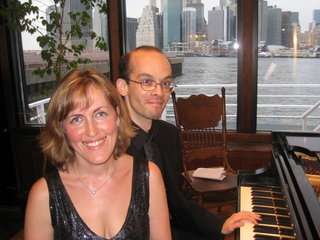|
Back
Fireworks And Filigrees New York
BargeMusic, Old Fulton Street, Brooklyn
06/13/2009 -
Johann Sebastian Bach: Fantasia in G Major for Organ, BWV 572 (arranged by Max Reger)
Győrgy Kurtág: Selections from Játékok (Games) and Arrangements of Johann Sebastian Bach
Franz Schubert: Fantasia in F Minor for Piano Duet (Opus posth 103, D.940)
Joahnnes Brahms: Selections from Sixteen Waltzes for Piano Four Hands, Opus 39 – Selections from Hungarian Dances, WoO 1
Antonín Dvorák: Selections from Slavonic Dances, Opus 46 and 72
Olga Vinokur, David Kalhous (Piano)

O. Vinokur, D. Kalhous (© Harry Rolnick)
Not Paderewski, Caruso, Yo-Yo, Fleming, Pavarotti, Rubinstein or Menuhin ever received the kind of fireworks which concluded the concert by duo-pianists Olga Vinokur and David Kalhous at BargeMusic last night. Hardly were they into the second of three Brahms Hungarian Dances when great booms began to echo all the way across the East River. And when they started the Third Hungarian Dance, the booms burst into glorious explosions of light, flares bursting into the sky, pinwheels, Roman Candles and radiant universes of stars to climax their performance.
Of course one could have excused the spectacle of son et lumičre as being part of the Flag Day celebrations with 20 minutes of fireworks coming from a barge moored in the river. And one could have appreciated the spacious view from behind the stage at BargeMusic which takes in the whole vista of the East River from the Statue of Liberty up to the Chrysler Building and beyond……
On the other hand, no artists with the even the least self-confidence could believe that these fireworks were anything but the appropriate appreciation and satisfaction for a job well done.
Yes, it was a stageworthy climax. But were these two young pianists worth the flashy show? Partly yes, partly no. Their program was imaginative, they are both certainly adept at their instruments, and they gave a good performance.
The problem was that four-handed piano music is not simply a technical trick. It isn’t enough to play in perfect coordination for success. And the team of Kalhous and Vinokur may still be at that stage where—like a tightrope walker—the accomplishment is its own reward.
This certainly wasn’t always true. The duo played five works by the great Hungarian composer Győrgy Kurtág which were not only enchanting in themselves but played with the elegant simplicity which they deserved.
The three short original works by Kurtág were great fun. One, a “furious chorale” was both percussive dance and part chorale, treble and bass playing against each other. The second, an homage to one “Halmági Minhály” was evidently dedicated to a master Hungarian folk musician, for the right hand played a kind of Magyar cymbalon, the zither-like instrument which Liszt himself tried to imitate. Mr. Kalhous did a tremulous beautiful job.
My own favorite was a jesting bagatelle. A “Prelude and Waltz in F” was literally that: the F-note repeated over and over again like the introduction to a Chopin Waltz. Just when you think the waltz is about to begin…
Well, the piece stops. A wonderful joke.
Two of the pieces were transcriptions of J. S. Bach chorales where the interlinking lines were so graceful, so elegant, that it took some doing to even realize that 20 fingers were handling them. That is, of course, the secret of four-hand piano playing, that one hears the music rather than sees the trick. But no matter how many hands were playing, they were the most artful transcriptions, played with great art.
Perhaps these Bach transcriptions sounded so good because they followed a Max Reger transcription of Bach’s Organ Fantasy in G Major. The two played it with brazen confidence, though I had the feeling that they were trying oh so hard to make certain they were playing together. Not that any spontaneity would have helped too much. The work sounded frankly musty, late 19th Century, very much like those terrible Bach orchestrations done by Gustav Mahler.
The following works were all very popular. Schubert’s Fantasia is an extended expression of songs which could well stand on their own. Here too Vinokur and Kalhous tried too hard. The graceful opening and closing were understated, beautifully done. In between, Schubert’s agitation turned almost violent, the tunes pounded out rather than dipping into inspired emotion.
One could settle down for the second half. Nothing could go wrong with Antonín Dvorák’s Slavonic Dances, and Mr. Kalhous, who is certainly a luminary in the Czech Republic, knew how to make them sing. I wasn’t in love with the Brahms waltzes, but compared to the original orchestral version, no piano can imitate the velvety strings and unerring grace.
Finally we had the fireworks of the Brahms Hungarian Dances. They were played with pleasure, humor and—thanks to the duo’s acknowledgement of the spectacle behind them—an honest, almost uncaring spontaneity.
Harry Rolnick
|